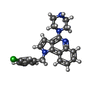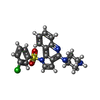+Search query
-Structure paper
| Title | Superiority of the Triple-Acting 5-HTR/5-HTR Antagonist and MAO-B Reversible Inhibitor over 5-HTR Antagonist Intepirdine in Alleviation of Cognitive Deficits in Rats. |
|---|---|
| Journal, issue, pages | J Med Chem, Vol. 66, Issue 21, Page 14928-14947, Year 2023 |
| Publish date | Nov 9, 2023 |
 Authors Authors | Katarzyna Grychowska / Uriel López-Sánchez / Mathieu Vitalis / Geoffrey Canet / Grzegorz Satała / Agnieszka Olejarz-Maciej / Joanna Gołębiowska / Rafał Kurczab / Wojciech Pietruś / Monika Kubacka / Christophe Moreau / Maria Walczak / Klaudia Blicharz-Futera / Ophélie Bento / Xavier Bantreil / Gilles Subra / Andrzej J Bojarski / Frédéric Lamaty / Carine Becamel / Charleine Zussy / Séverine Chaumont-Dubel / Piotr Popik / Hugues Nury / Philippe Marin / Laurent Givalois / Paweł Zajdel /    |
| PubMed Abstract | The multifactorial origin and neurochemistry of Alzheimer's disease (AD) call for the development of multitarget treatment strategies. We report a first-in-class triple acting compound that targets ...The multifactorial origin and neurochemistry of Alzheimer's disease (AD) call for the development of multitarget treatment strategies. We report a first-in-class triple acting compound that targets serotonin type 6 and 3 receptors (5-HT-Rs) and monoamine oxidase type B (MAO-B) as an approach for treating AD. The key structural features required for MAO-B inhibition and 5-HTR antagonism and interaction with 5-HTR were determined using molecular dynamic simulations and cryo-electron microscopy, respectively. Bioavailable reversed scopolamine-induced cognitive deficits in the novel object recognition test. Furthermore, it displayed superior pro-cognitive properties compared to intepirdine (a 5-HTR antagonist) in the AD model, which involved intracerebroventricular injection of an oligomeric solution of amyloid-β peptide (oAβ) in the T-maze test in rats. , but not intepirdine, restored levels of biomarkers characteristic of the debilitating effects of oAβ. These data support the potential of a multitarget approach involving the joint modulation of 5-HTR/5-HTR/MAO-B in AD. |
 External links External links |  J Med Chem / J Med Chem /  PubMed:37797083 / PubMed:37797083 /  PubMed Central PubMed Central |
| Methods | EM (single particle) |
| Resolution | 3.0 - 3.2 Å |
| Structure data | EMDB-16555, PDB-8cc6: EMDB-16557, PDB-8cc7: |
| Chemicals |  ChemComp-NAG:  ChemComp-U9L:  ChemComp-U9Q: |
| Source |
|
 Keywords Keywords | TRANSPORT PROTEIN / Ion channel / Receptor / pLGIC |
 Movie
Movie Controller
Controller Structure viewers
Structure viewers About Yorodumi Papers
About Yorodumi Papers








